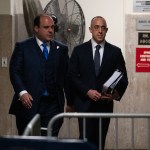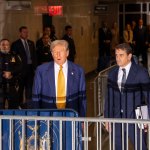Bart Gellman and Jo Becker continue their excellent series on Vice President Dick Cheney with an exquisite piece on Cheney’s role in interrogations. At every stage in the post-9/11 debate, Cheney and his staff sought to enshrine torture as official U.S. policy, relying on a legalistic distinction between “torture” and “cruelty.”
David S. Addington, Cheney’s general counsel, set the new legal agenda in a blunt memorandum shortly after the CIA delegation returned to Langley. Geneva’s “strict limits on questioning of enemy prisoners,” he wrote on Jan. 25, 2002, hobbled efforts “to quickly obtain information from captured terrorists.”
No longer was the vice president focused on procedural rights, such as access to lawyers and courts. The subject now was more elemental: How much suffering could U.S. personnel inflict on an enemy to make him talk? Cheney’s lawyer feared that future prosecutors, with motives “difficult to predict,” might bring criminal charges against interrogators or Bush administration officials.
Geneva rules forbade not only torture but also, in equally categorical terms, the use of “violence,” “cruel treatment” or “humiliating and degrading treatment” against a detainee “at any time and in any place whatsoever.” The War Crimes Act of 1996 made any grave breach of those restrictions a U.S. felony [Read the act]. The best defense against such a charge, Addington wrote, would combine a broad presidential direction for humane treatment, in general, with an assertion of unrestricted authority to make exceptions.
The vice president’s counsel proposed that President Bush issue a carefully ambiguous directive. Detainees would be treated “humanely and, to the extent appropriate and consistent with military necessity, in a manner consistent with the principles of” the Geneva Conventions. When Bush issued his public decision two weeks later, on Feb. 7, 2002, he adopted Addington’s formula — with all its room for maneuver — verbatim.
In a radio interview last fall, Cheney said, “We don’t torture.” What he did not acknowledge, according to Alberto J. Mora, who served then as the Bush-appointed Navy general counsel, was that the new legal framework was designed specifically to leave room for cruelty. In international law, Mora said, cruelty is defined as “the imposition of severe physical or mental pain or suffering.” He added: “Torture is an extreme version of cruelty.”
Again and again on detentions and interrogations policy, Cheney’s coterie insisted on what Reagan-era Justice official Bruce Fein calls “monarchical claims.” David Addington, Cheney’s lawyer and now chief of staff, had set up a “private channel” with John Yoo — the champion of near-unlimited wartime presidential authority in the Justice Department’s Office of Legal Counsel — at the Justice Department, squelching several of the department’s concerns before they bubbled up to President Bush. Not even officials who agreed with the Cheney-Addington-Yoo line were safe from retribution:
Ashcroft, with support from Gonzales, proposed a lawyer named Patrick Philbin for deputy solicitor general. Philbin was among the authors of the post-9/11 legal revolution, devising arguments to defend Cheney’s military commissions and the denial of habeas corpus rights at Guantanamo Bay. But he had tangled with the vice president’s office now and then, objecting to the private legal channel between Addington and Yoo and raising questions about domestic surveillance by the National Security Agency.
Cheney’s lawyer passed word that Philbin was an unsatisfactory choice. The attorney general and White House counsel abandoned their candidate.
It’s a side point, but it seems from the piece that after years of vilification, Yoo wants to spread some of the responsibility to Addington. Yoo says he intended a secret memorandum justifying torture in CIA interrogations for the CIA alone — as the CIA interrogates only the highest-value al-Qaeda operatives — but Cheney and Donald Rumsfeld insisted on allowing the military access to the same tactics.
But the “torture memo,” as it became widely known, was not Yoo’s work alone. In an interview, Yoo said that Addington, as well as Gonzales and deputy White House counsel Timothy E. Flanigan, contributed to the analysis.
The vice president’s lawyer advocated what was considered the memo’s most radical claim: that the president may authorize any interrogation method, even if it crosses the line of torture. U.S. and treaty laws forbidding any person to “commit torture,” that passage stated, “do not apply” to the commander in chief, because Congress “may no more regulate the President’s ability to detain and interrogate enemy combatants than it may regulate his ability to direct troop movements on the battlefield.”
That same day, Aug. 1, 2002, Yoo signed off on a second secret opinion, the contents of which have never been made public. According to a source with direct knowledge, that opinion approved as lawful a long list of specific interrogation techniques proposed by the CIA — including waterboarding, a form of near-drowning that the U.S. government classified as a war crime in 1947. The opinion drew the line against one request: threatening to bury a prisoner alive.
It’ll be interesting to see how the revelation that CIA wanted the authority to threaten live burial affects the nomination of John Rizzo — a longtime CIA attorney — to become the agency’s general counsel.





 Today’s Must Read
Today’s Must Read


